Bulgur pilaf (or bulgur pilavi as we call it in Turkish) is one of those dishes almost every Turkish family grows up with. For us, it’s the ultimate side dish. It pairs well with nearly anything on the table, but honestly, we often enjoy it just by itself with a bowl of yogurt on the side.
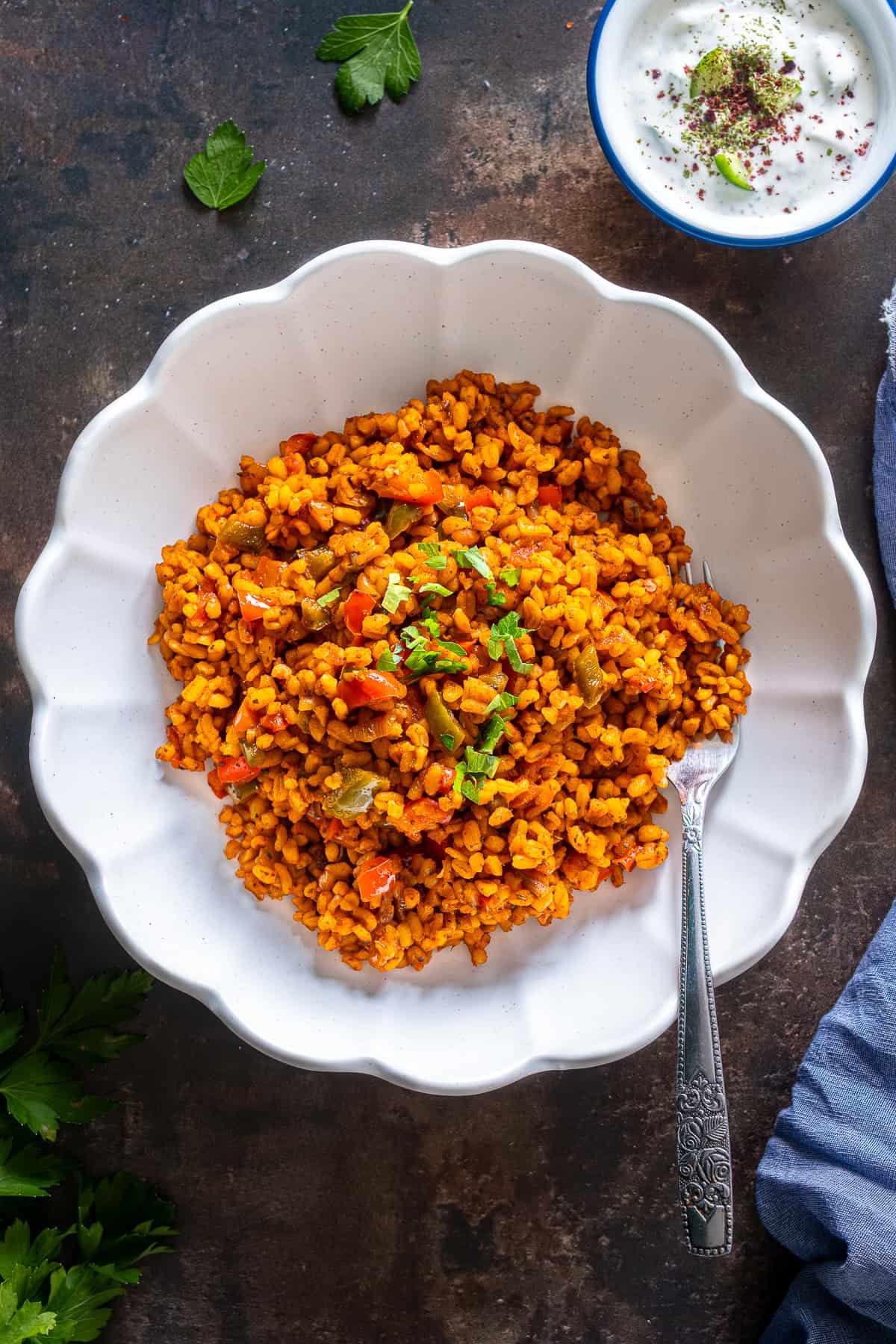
The Most Traditional Side Dish in Turkey
In Turkish cuisine, bulgur pilavi is one of the most traditional side dishes. Whatever the main meal is, there’s a good chance this pilaf will be served right next to it. When we ask ourselves “What should we cook on the side tonight?” the answer is often bulgur pilaf.
Maybe it’s because bulgur is more budget-friendly than rice or simply because it’s easier to cook.
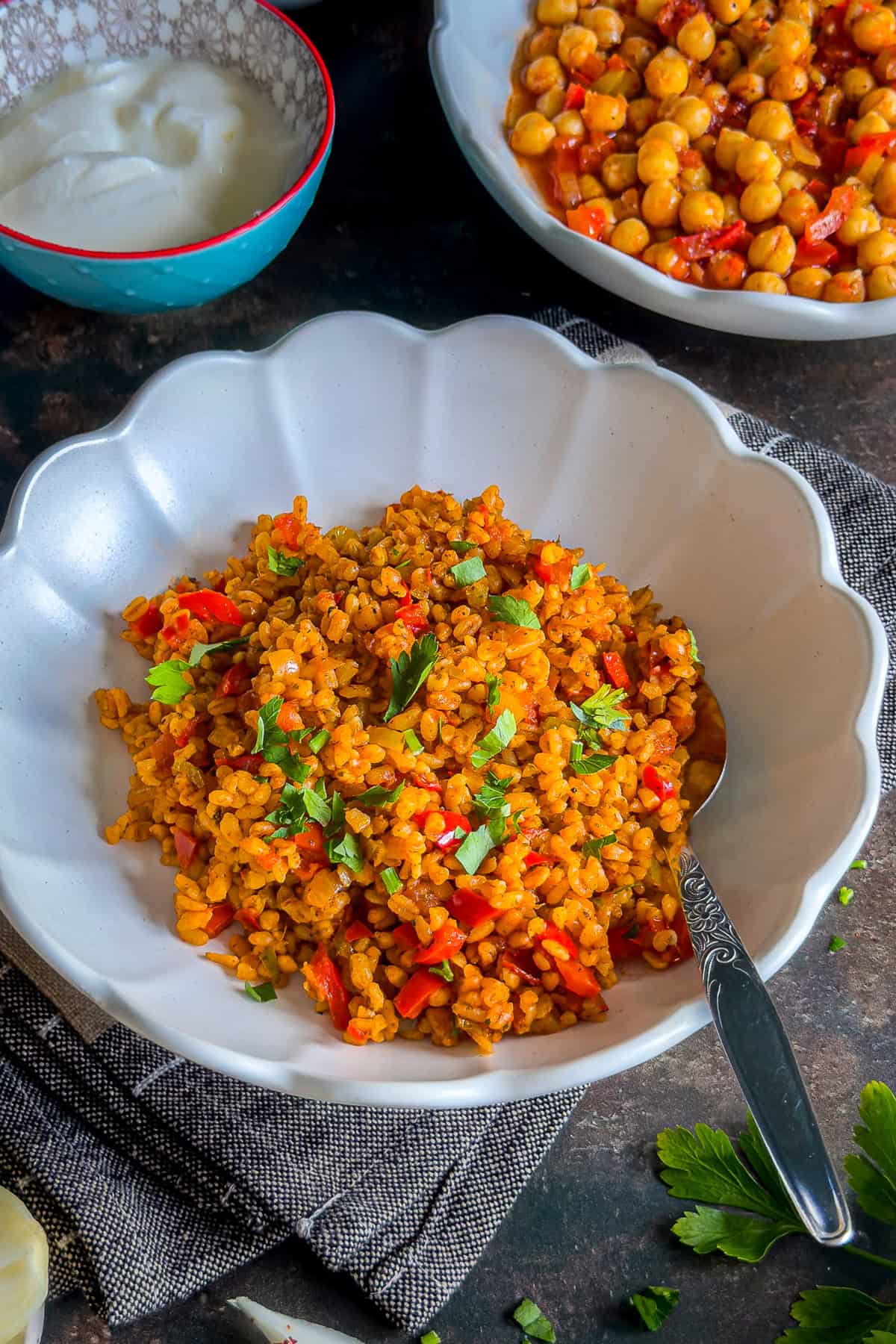
Also, bulgur has always felt like true countryside food. If you have roots in a village like we do, you’ll know exactly what we mean; bulgur pilavi is the go-to choice.
There are several versions of bulgur pilavi in Turkey, but today we’re talking about the most popular one: domatesli bulgur pilavi — bulgur pilaf with tomatoes.
About The Ingredients
You can find the full list of ingredients with exact measurements in the recipe card below.
Here, let’s quickly talk about what goes into bulgur pilavi. Well, you don’t need anything fancy, just a few simple ingredients. Some of them are optional, but we think they really make a difference.
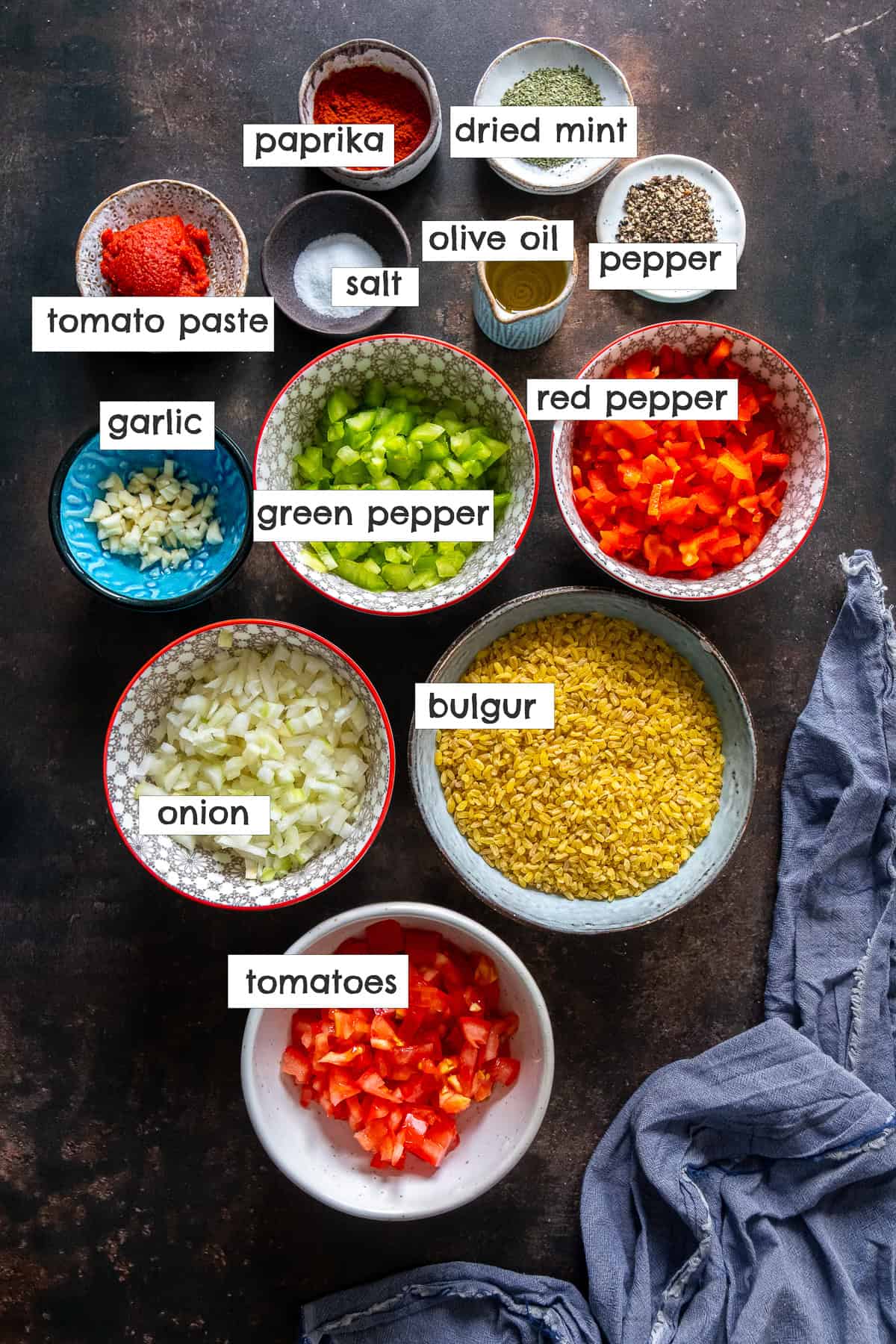
- Bulgur (cracked wheat): For this recipe, you definitely need coarse or extra coarse bulgur wheat. You can usually find it at Middle Eastern grocery stores.
- Tomatoes: We usually use fresh chopped tomatoes, but canned ones work fine too.
- Green pepper: A must-have ingredient in Turkish bulgur pilaf. You can use a small green bell pepper or one Turkish carliston biber (similar to banana pepper). We also like to add a red pepper for extra color and flavor.
- Garlic (optional but highly recommended): Adds a wonderful extra layer of flavor.
- Spices: Salt, black pepper, paprika, and dried mint. Don’t skip any of these, they are what make the pilaf taste so good.
- Water: We keep it simple and only use water, but you can use chicken or vegetable stock if you prefer. We just love the plain version.
How to Make Bulgur Pilavi
You can find the full instructions in the recipe card at the end of this post. But really, there isn’t an easier side dish than this. Here’s how it goes:
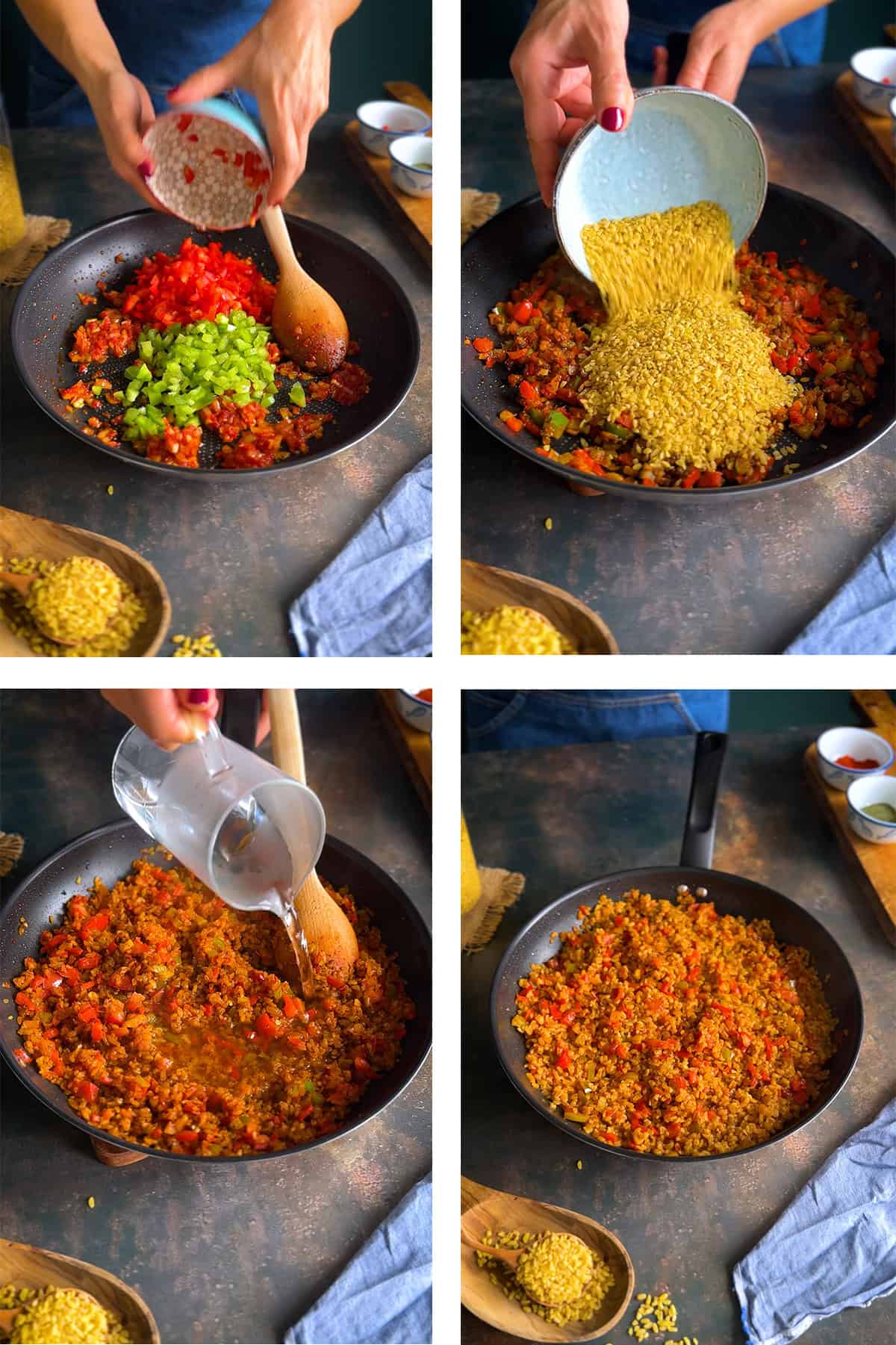
First, sauté the onion in olive oil. Stir in the tomato paste, then add finely diced garlic. Next, toss in the chopped peppers and season with spices. Cook until the peppers start to soften.
Add the bulgur and stir it for a couple of minutes. Then add the tomatoes, cover the pan, and let them cook gently until they soften a little. Carefully pour in hot water, bring it to a boil, then cover and cook on the lowest heat until all the liquid is absorbed.
Turn off the heat and let the pilaf rest for about 15 minutes with the lid on. Finally, fluff it gently with a spoon and serve.
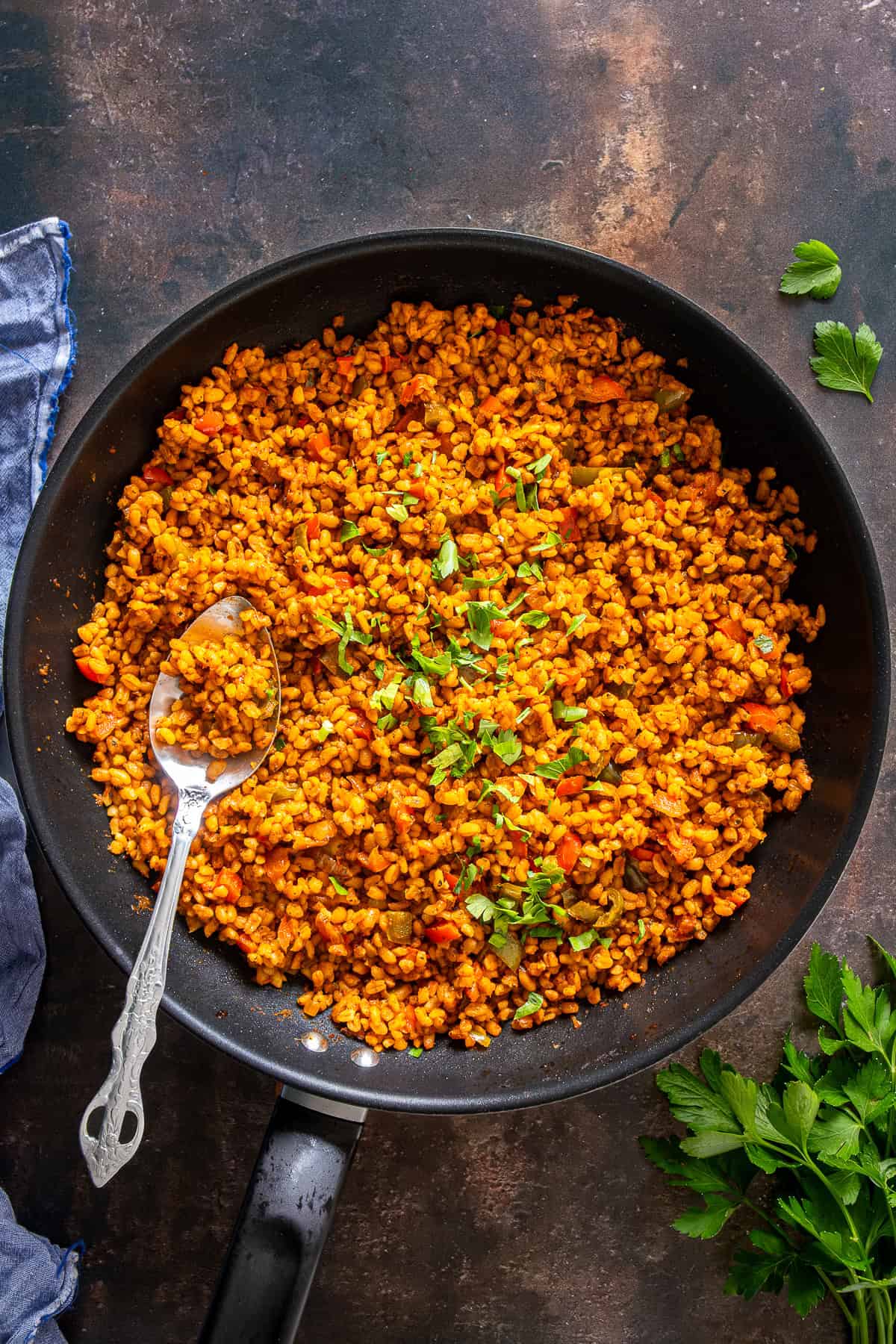
Don’t Use Fine Bulgur to Make Pilaf!
For this recipe, you need coarse, medium coarse, or extra coarse bulgur, never fine bulgur. Fine bulgur is very thin and doesn’t even need cooking. In Turkey, it’s never used for bulgur pilavi. Instead, it’s mostly used in recipes like kısır, bulgur salad.
So make sure to pick the right type of bulgur to get that perfect texture.
Water Ratio Tips
The amount of water needed can change depending on the type of bulgur you use.
The ratio we share here works best for medium coarse and extra coarse bulgur. If your pilaf still feels a bit firm after cooking, don’t worry. Just add a little more hot water (about ¼ cup), cover again, and let it simmer on low heat. The bulgur will absorb the extra water and turn out just right.
Serving Suggestions
Bulgur pilavi is such a versatile side dish, it goes well with almost any meal. Our favorite pairings are with classic Turkish stews like kuru fasulye (bean stew), nohut yemeği (chickpea stew), taze fasulye (green beans), or Turkish beef stew.
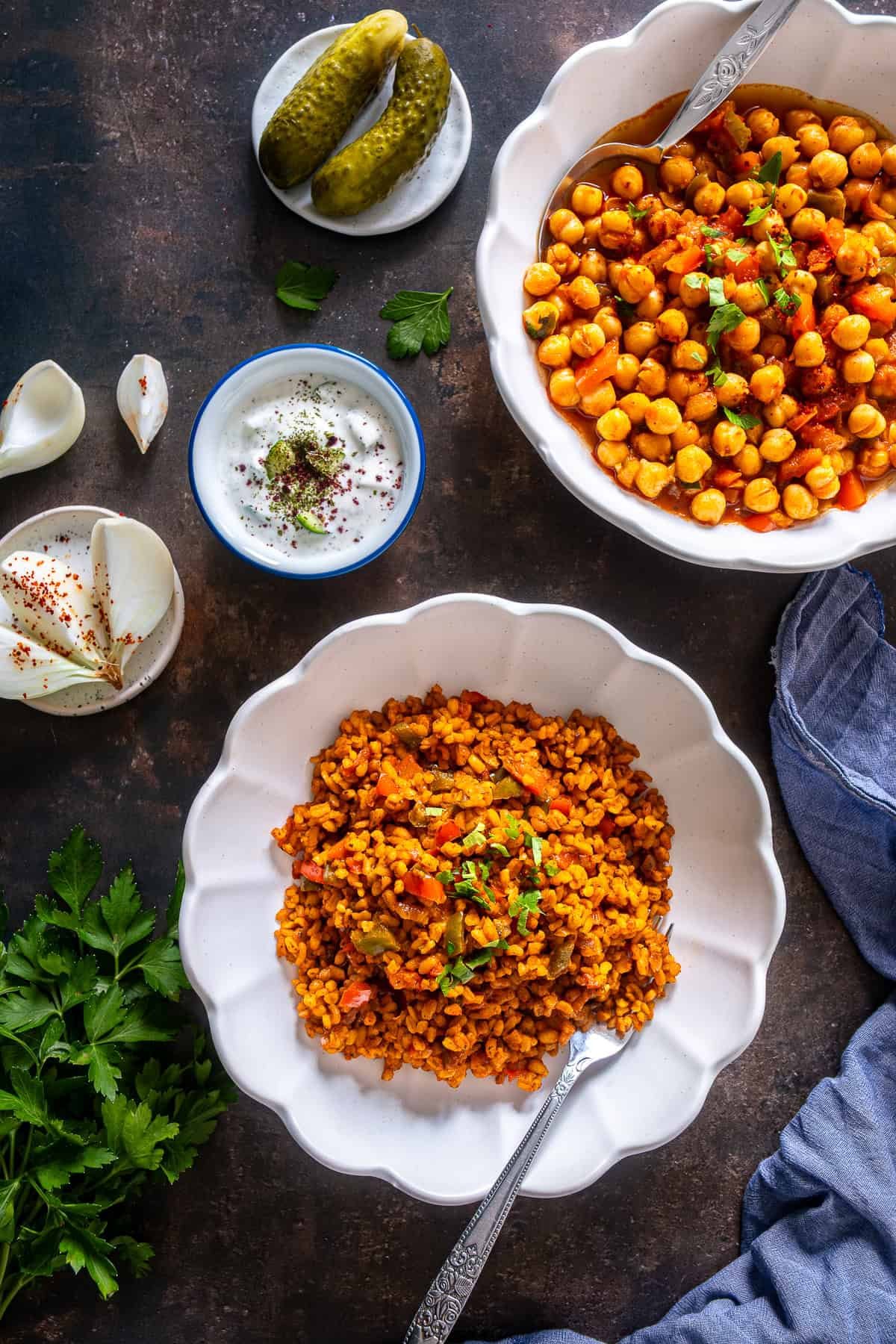
It also matches perfectly with grilled dishes like köfte (meatballs) or chicken.
Add a simple shepherd salad or a bowl of cacık (yogurt with cucumber) on the side, and you’ve got a perfect meal.
And here’s a little bonus: if you have leftovers, bulgur pilavi makes a quick main dish the next day, just serve it with some Turkish yogurt and you’re set.
Storage & Reheating Tips
If you have leftovers, let the bulgur pilaf cool completely before storing it. Keep it in an airtight container in the fridge, and it will stay fresh for up to 3–4 days.
To reheat, just warm it in a pan over low heat. Add a splash of water, cover, and let it steam until heated through. You can also reheat it in the microwave, again, with a little water so it doesn’t dry out.
As always: If you make this recipe, let us know what you think by rating it and leaving a comment below. And post a pic on Instagram too—tag @give_recipe so we can see!
Sign up for the FREE GiveRecipe Newsletter to get the new recipes into your inbox! And stay in touch with us on Facebook, Pinterest, YouTube and Instagram for all the latest updates.
📖 Recipe

Bulgur Pilavi (Bulgur Pilaf)
INGREDIENTS
- 2 tablespoons olive oil
- 1 onion medium, finely chopped
- 1 tablespoon tomato paste
- 2 cloves garlic finely diced
- 1 green pepper finely diced
- 1 red pepper finely diced
- 1 cup bulgur extra coarse
- 1 teaspoon salt
- 1 teaspoon paprika
- 1 teaspoon dried mint
- ½ teaspoon black pepper
- 2 tomatoes medium, diced
- 1½ cups hot water
INSTRUCTIONS
- Heat olive oil in a pan and sauté the chopped onion until soft.
- Stir in the tomato paste, then add diced garlic and cook for 1 minute.
- Add diced peppers and cook until they start to soften.
- Add the bulgur and spices. Cook for 2–3 minutes, stirring occasionally.
- Stir in the chopped tomatoes and cook for another 2–3 minutes until softened.
- Carefully pour in the hot water. Bring to a boil.
- Reduce the heat to the lowest, cover, and cook for about 15 minutes or until the water is absorbed.
- Remove from heat and let it rest, covered, for at least 15 minutes before serving.
NOTES
- Do not cook the bulgur over high heat.
- Bring the mixture to a boil, then reduce the heat to its lowest possible setting. Remember to keep your lid on the pot to prevent moisture from evaporating.
- You cannot use fine bulgur for this pilaf recipe. Pilaf has to have some texture otherwise it turns out more like couscous. Medium, coarse or very coarse bulgur will work best and give a nice mouth-feel.
- Allowing your bulgur to rest before serving it is another essential step, especially for coarse and very coarse bulgur. This allows the grains to continue cooking without losing additional moisture.
NUTRITION
Nutrition information is automatically calculated, so should only be used as an approximation.



Christine says
The recipe I have always used is almost exactly the same. After making it this way I will never use my recipe again. My recipe used a whole diced zucchini but no tomato. Using fresh tomatoes is much more flavorful. I made it with chickpea stew, cacik, and some leftover sumac onions. I'm in heaven! Thank you for your efforts!!
Zerrin & Yusuf says
We’re so happy you enjoyed our version, fresh tomatoes really do make a big difference. Thank you for sharing your lovely combo and for your kind words!
Sandy W says
Whoops! Forgot to give it five stars.
Zerrin & Yusuf says
Thank you so much!
Sandy W says
Delicious. Have made it with meatballs, chicken and halloumi cheese (not all at once!). Everyone loves it, grandchildren included.
The spicing is spot-on as it is, but I sometimes add pul biber chilli flakes. Thank you.
Zerrin & Yusuf says
So happy to hear that everyone loves it, Sandy! It goes so well with all those dishes and yes, a little pul biber on top makes it even better!
Fareeda says
I forgot to give it a star rating. Definitely *****(5) stars.
I had it for dinner last night, and I am now having the leftovers for lunch today.
Zerrin & Yusuf says
Hi Fareeda,
Awww, it's very kind of you! Thank you so much for the five-star rating and coming back for a second feedback! We do the same, leftovers make a perfect quick lunch.
Fareeda says
Very delicious. I made half a batch. I ran out of red/green peppers, so substituted with riced cauliflower and boiled chick peas. Tasted devine.
Thanks
Zerrin & Yusuf says
Hi Fareeda,
So happy to hear that you loved bulgur pilavi! Adding cauliflower and chickpeas is a brilliant idea!